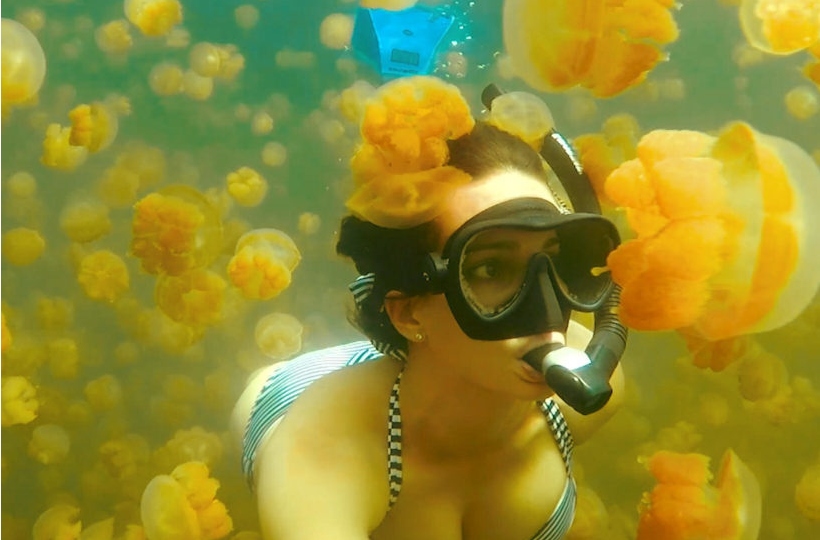
While swimming in a lake filled with jellyfish doesn’t sound too inviting..seeing this footage might change your mind completely.
What is Jellyfish Lake?
This beautiful lake is located on Eil Malk Island, part of Palau’s Rock Islands, and is famous with tourists because it’s teeming with a unique species of jellyfish—the golden jellyfish. These jellies don’t exist anywhere else in the world and have stingers so small that humans can’t feel them, making their habitat a popular and safe one to swim in.
The isolated saltwater lake is unique because it is surrounded by connections to the Pacific Ocean, yet it is meromictic (its layers don’t mix). At 400 metres long and 30 metres deep, the lake’s bottom layer is hypoxic (there’s no oxygen), the middle layer is full of bacteria, and the top layer is a jellyfish haven. It’s that top layer that tourists have historically swam in with snorkeling gear, encountering the jellies up close. (The hypoxic bottom layer is deadly to humans, making diving dangerous.) Sunscreen is also prohibited since it can affect the ecosystem.
A unique ecosystem
The golden jellyfish are harmless and stick to themselves despite the tourist influx over the years, using their small stinging cells to capture zooplankton for food. In their second, mature lifecycle known as the medusa, the jellies contain symbiotic algae in their tissues that help to sustain them. In order for the algae to photosynthesis, the jellyfish are constantly seeking the sun and migrate towards it all day long.
For that reason they avoid shadowy parts of the lake, which is also where jellies’ natural predators, anemones, reside. If the jellies get too close to the edge (or to a fallen tree in the sunlit part of the lake), anemones will immobilize and slowly ingest them.
Global warming
Sadly the World Heritage Site now closes intermittently because the jellyfish are dying out as a result of global warming and the effects of El Niño. In 2016 the Coral Reef Research Foundation estimated the jellyfish population had fallen from eight million to a mere 600,000, resulting in many tour operators cancelling trips.
Experts hope that polyps (an early stage in the jellyfish lifecycle) will eventually produce a new generation of jellyfish if and when conditions like the current rainfall levels improve.
“It’s difficult to tease out what is happening in the lake,” marine biologist David Gruber tells National Geographic. “Is it natural fluctuation or climate change? This highlights why we need long-term monitoring of places, so we can understand these systems more.”
In the meantime, Jellyfish Lake is currently open… for now.
Why you should visit
Marine biologist David Robinson travelled to the lake in 2009, when the population was much higher than it is now. Still he remembers “being in the lake itself is an exceptional experience. It’s very surreal swimming in such a beautiful lake filled with beautiful jellies.”
Karen Nye, who has travelled extensively across the Pacific in search of World War II wrecks, headed to Jellyfish Lake more recently—in 2015.
“We arrived via a short boat ride from Koror,” she recalls. “After walking a short distance we came across the internal lake within the island. After gearing up with our mask, snorkel, and fins, we dived in to discover such an abundance of jellyfish. The further we swam into the lake the jellyfish became thicker in population. It was such an incredible experience.”
Nye recommends travellers have a bit of snorkeling experience before going, and to respect the environment there so that visitors can enjoy the spot as long as possible. Madlen Mueller, who travelled there in May this year and saw fewer jellies than expected, agrees.
“You have to get to the island by boat; it’s a very peaceful, stunning place in the nature. The landscape is already worth a visit before jumping into the lake,” she says. “The water in the lake was slightly green and blurry. I was disappointed as there were actually not so many jellyfish. They don’t really care about the swimmers and just chill there. There weren’t many tourist during that time, probably because of less jellyfish.”
New hope
While the future of Jellyfish Lake remains unclear, scientists are now discovering other such jellyfish-infested lakes in Thailand. They hope to bring new knowledge and the necessary tools to these ecosystems in order to study them and preserve them, which may one day help them to figure out a way to save the former Palau hotspot too.
